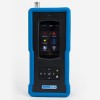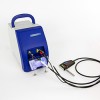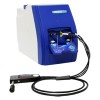
Pharmaceutical, Nutraceutical & Cosmetics
Rapid analytical tools that can be used from incoming material receipt, through manufacturing stages, all the way to final product testing are needed, especially in the industries where product quality can impact end users’ safety, including pharmaceuticals, food manufacturing, and cosmetics. Mobile Raman spectroscopy solutions including are designed for expert and non-expert users to verify material identity and quality at all stages.
Raman spectroscopy is a well-established molecular spectroscopic technique for noninvasive and nondestructive chemical analysis, requiring no sample preparation, and with the ability to make measurements through transparent packing such as plastic or glass. Our advanced STRaman™ technology has added capabilities to make measurements through opaque packaging as well. The Raman spectrum provides a unique chemical fingerprint that is used in the identity of materials.
The chemical information within a Raman spectrum can also be used to elucidate chemical structures, give information on a sample’s chemical composition, a product’s content uniformity, as well as structural information such as the level of crystallinity and crystalline form. Because of the specific information provided by Raman spectroscopy, it is an invaluable tool for the pharmaceutical industry from at all stages of research, product and process development, manufacturing, and counterfeit detection.
The positive identification of all raw materials is required before they are used. Raman spectroscopy can be used for identification of most organic and inorganic materials alike. B&W Tek’s NanoRam handheld provides complementary solutions for incoming material inspection.
The rapid, nondestructive nature of Raman spectroscopy makes it an integral tool in screening of new products for their identity and solid form, and the study of phase transformations. Due to its high chemical specificity, and ability to measure liquids and solids alike, Raman can be used for reaction monitoring to understand chemical reaction kinetics, and formation of intermediates, and end products. It can identify materials including active pharmaceutical ingredients, excipients, intermediates, and solvents.
Portable Raman spectrometers such as the i-Raman series, are fiber-optically coupled, and provide versatility for use in lab, pilot plant, production, or field environments Raman has the advantage over other techniques for its ability to provide rapid results with little or sample preparation, and minimal sample handling. It provides fast, accurate results aiding in Pharmaceutical product development, manufacturing and QC for qualitative as well as quantitative analysis.
The content uniformity of solid dosage forms can be measured using transmission Raman spectroscopy, as offered with the QTRam™. Transmission Raman is effective for measuring over a larger sampling volume, and system design with a larger sampling are also gives more representative sampling for blend uniformity testing.
Products
High throughput, Highly Sensitive, High Resolution Raman System
Highly Sensitive, High Resolution Fiber Optic Raman System
Testimonials
The NanoRam was the most suitable Raman instrument on the global market, significantly reducing the time spent and as a result increasing the efficiency of our API control process.
— PharmstandardThe NanoRam is so easy to use, and we are now able to get through hundreds of samples per day, allowing us to fulfill regulatory requirements of 100% identification testing of APIs
— HeteroRequest a Quote or Information
Application Notes
Read the full application note
Read the full application note
Read the full application note
Read the full application note
Read the full application note
Read the full application note
Read the full application note
Read the full application note
Read the full application note
Read the full application note
Read the full application note
Read the full application note
Read the full application note
Read the full application note
Read the full application note
Read the full application note
Read the full application note
Read the full application note
Read the full application note
Read the full application note



